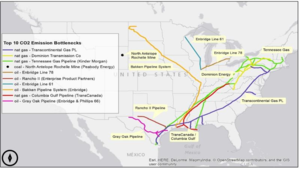
Due to market failures that allow uncompensated negative externalities from burning fossil fuels, there has been a growing call for climate change-related litigation targeting polluting companies. To determine the most intensive carbon dioxide (CO2)-emitting facilities in order prioritize liability for climate lawsuits, and risk mitigation strategies for identified companies as well as their insurers and investors, two methods are compared: (1) the conventional point-source method and (2) the proposed bottleneck method, which considers all emissions that a facility enables rather than only what it emits. Results indicate that the top ten CO2 emission bottlenecks in the U.S. are predominantly oil (47%) and natural gas (44%) pipelines. Compared to traditional point-source emissions methods, this study has demonstrated that a comprehensive bottleneck calculation is more effective. By employing an all-inclusive approach to calculating a polluting entity's CO2 emissions, legal actions may be more accurately focused on major polluters, and these companies may preemptively mitigate their pollution to curb vulnerability to litigation and risk. The bottleneck methodology reveals the discrete link in the chain of the fossil-fuel lifecycle that is responsible for the largest amount of emissions, enabling informed climate change mitigation and risk management efforts.
See also[edit | edit source]

keywords = carbon emissions, greenhouse gas emissions, global catastrophic risk, climate change, energy policy, human mortality, climate genocide
- Liability for carbon emissions literature review
- Ekwurzel, B., J. Boneham, M.W. Dalton, R. Heede, R.J. Mera, M.R. Allen, & P.C. Frumhoff (2017) The rise in global atmospheric CO2, surface temperature, and sea level from emissions traced to major carbon producers, Climatic Change[1]
- Shue, Henry (2017) Responsible for What? Carbon Producer CO2 Contributions and the Energy Transition, Springboard Commentary on Ekwurzel et al., Climatic Change, online [2]
--
Follow up
- http://blog.ucsusa.org/elliott-negin/will-new-scientific-breakthroughs-pave-the-way-for-more-climate-related-lawsuits
- Heede, R. (2014). Tracing anthropogenic carbon dioxide and methane emissions to fossil fuel and cement producers, 1854–2010. Climatic Change, 122(1-2), 229-241. https://link.springer.com/article/10.1007/s10584-013-0986-y
In the News[edit | edit source]
- MTU Researchers Introduce New Theory to Calculate Emissions Liability MTU News 20.9k (noon Friday)
- Mirage92k
- Serendeputy 69k
- The National Tribune
- Environmental News Network 235k
- YouTube Today's Sciencology
- New Theory to Calculate Emissions Liability—"A Profound Business Risk for Some Companies" NewsWise 50.2k
- Researchers introduce new theory to calculate emissions liability Eureka Alert 19.4k
- Questioning conventional methods of calculating carbon emissions liability based on point source pollution PV Buzz
- MTU Researchers Introduce New Theory to Calculate Emissions Liability Revo30
- Researchers Introduce New Theory to Calculate Emissions Liability Lab Manager 105k
- New study: Many critical carbon emissions bottlenecks in the U.S. are not even American EI News 39k
- The Missing Data Behind Manchin's Dirty Pipeline Deal Lever News















